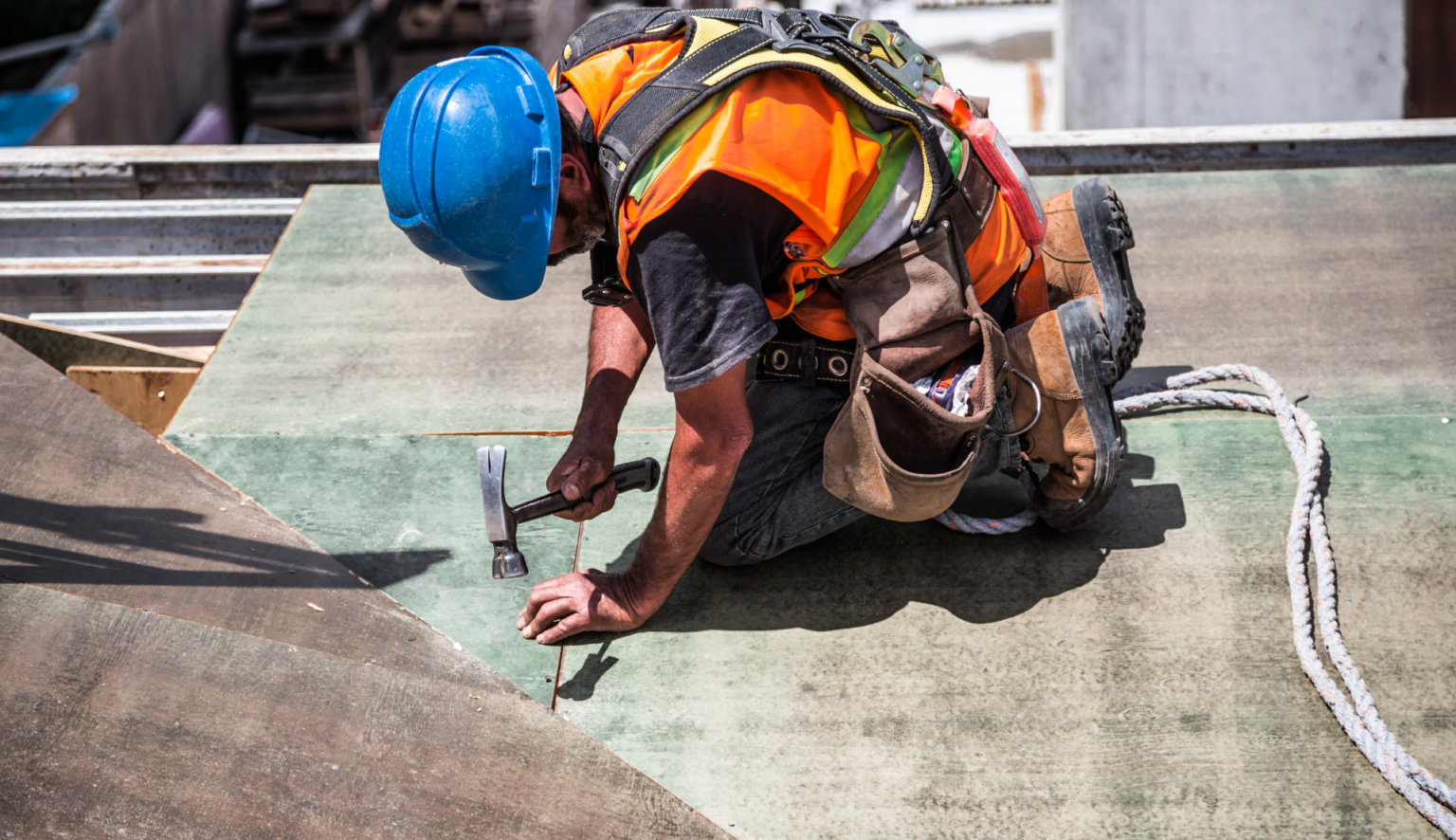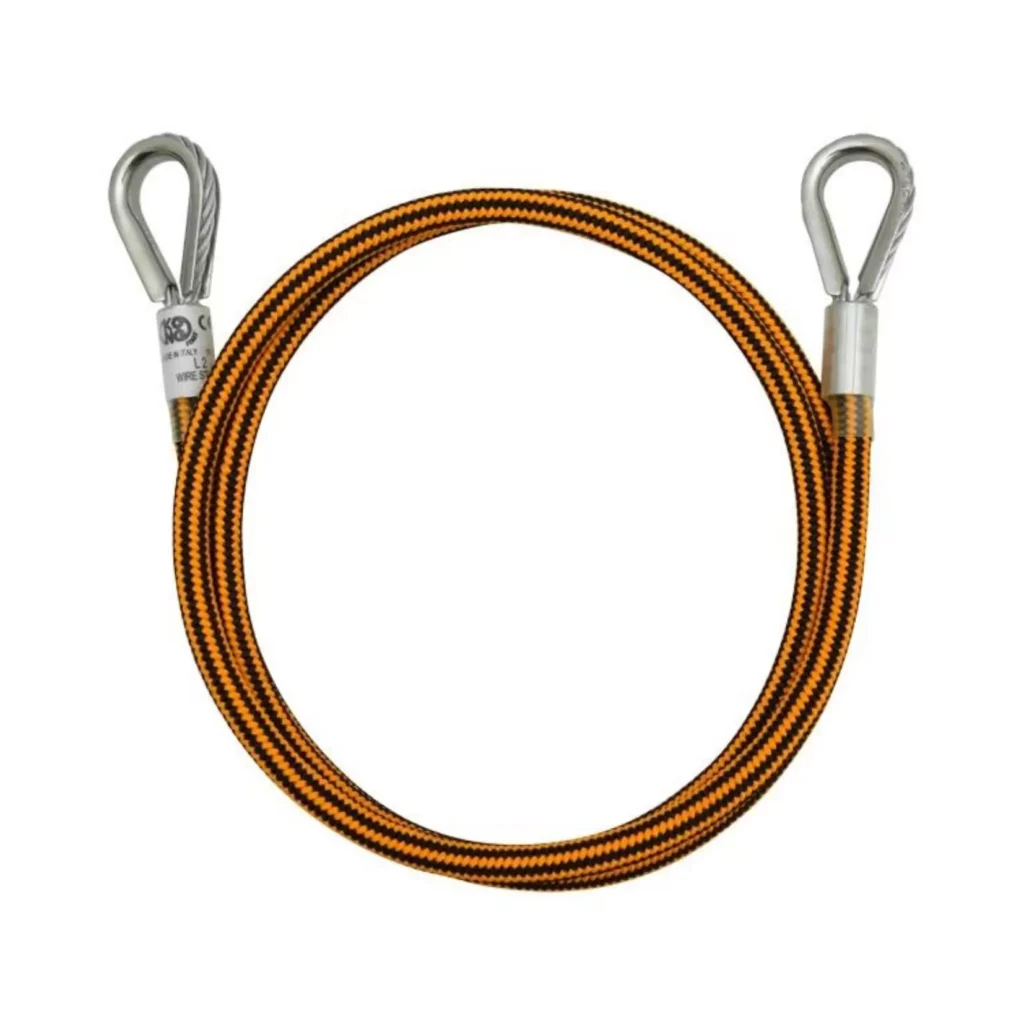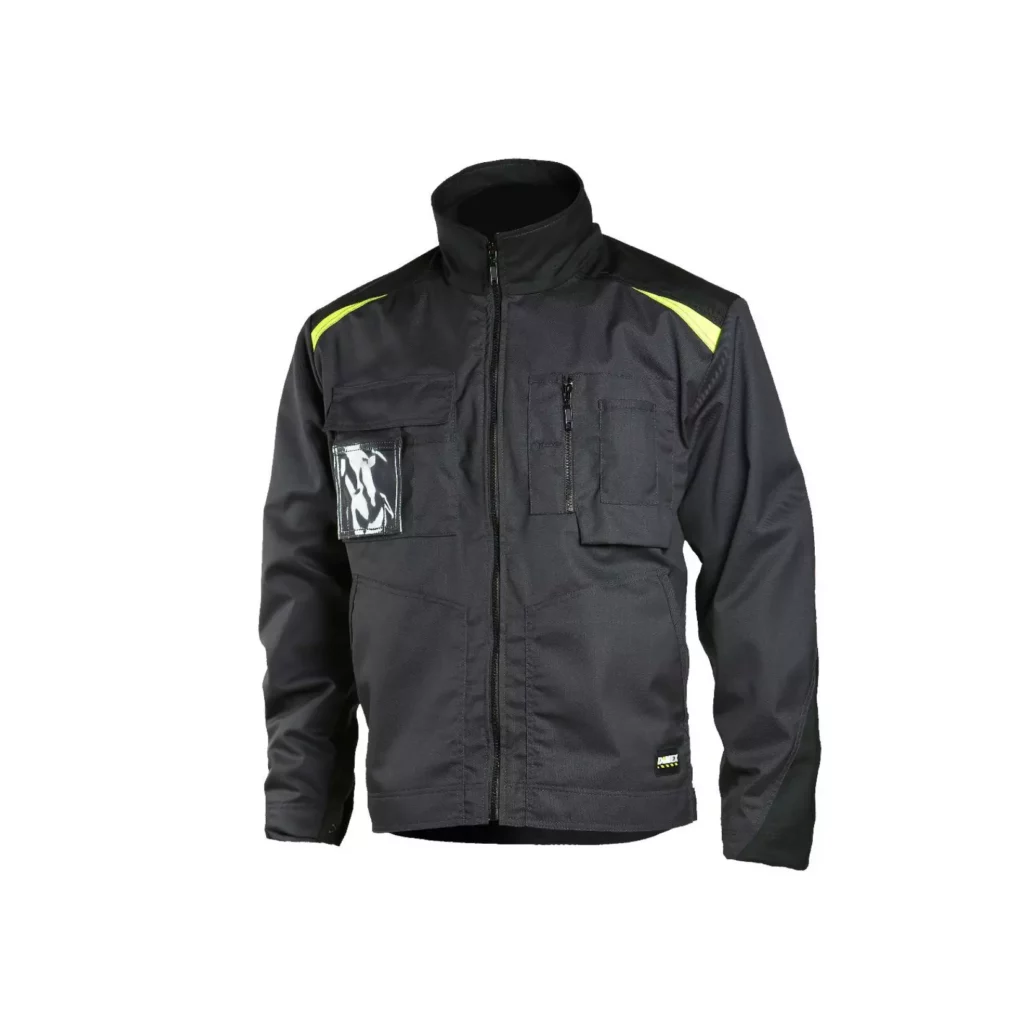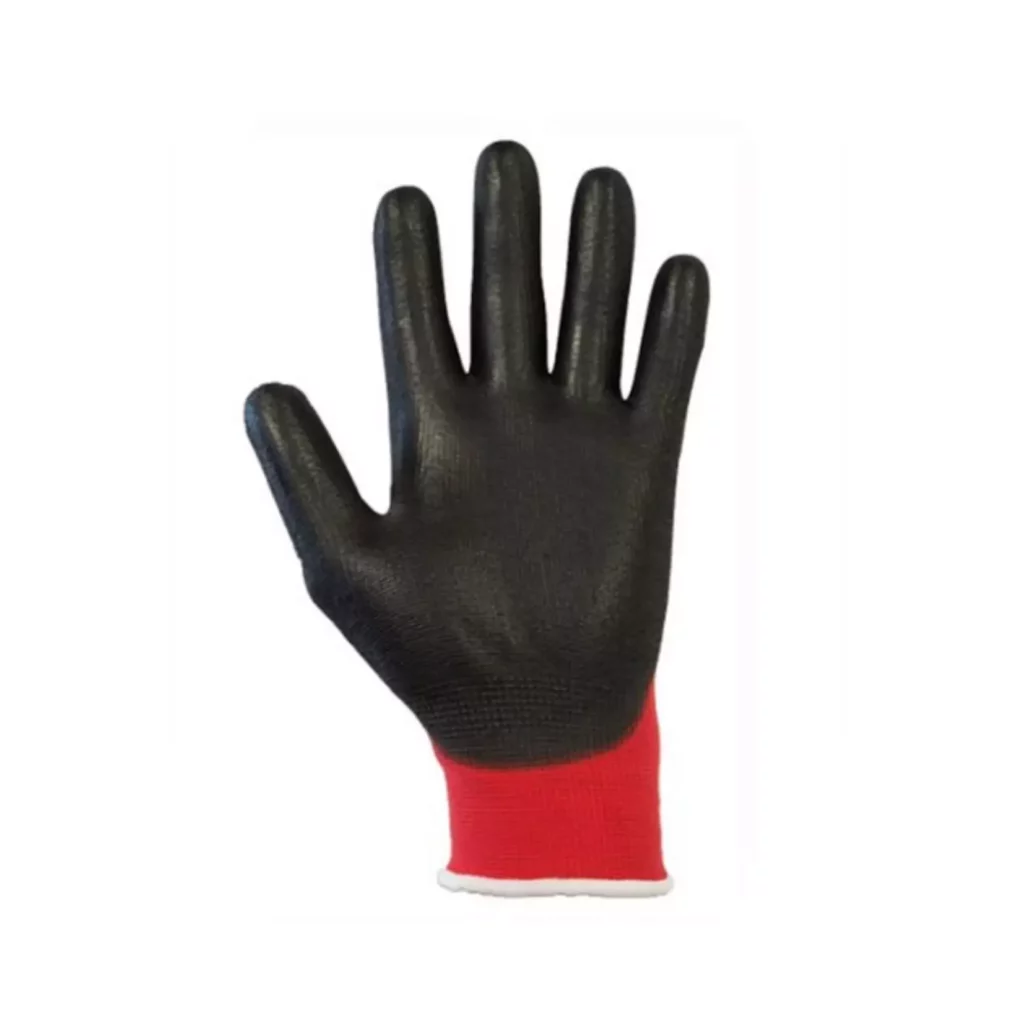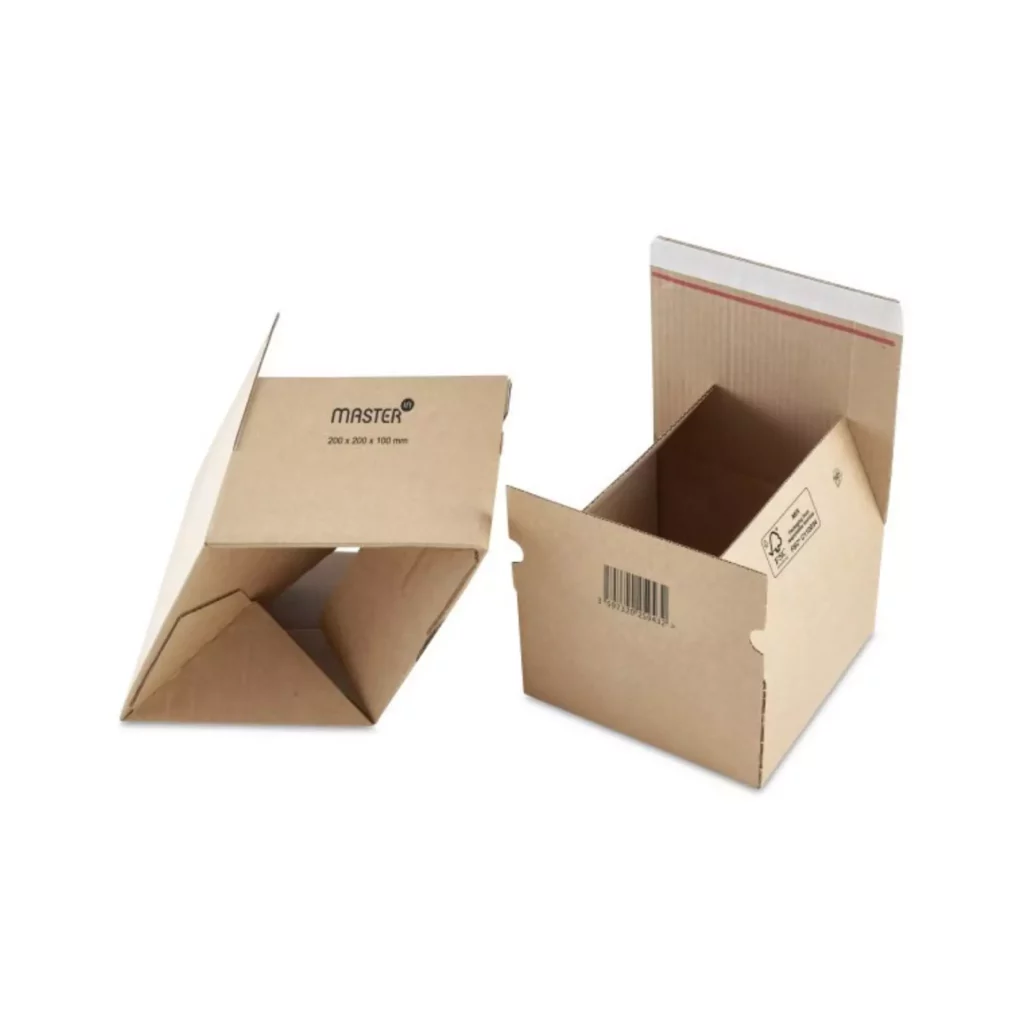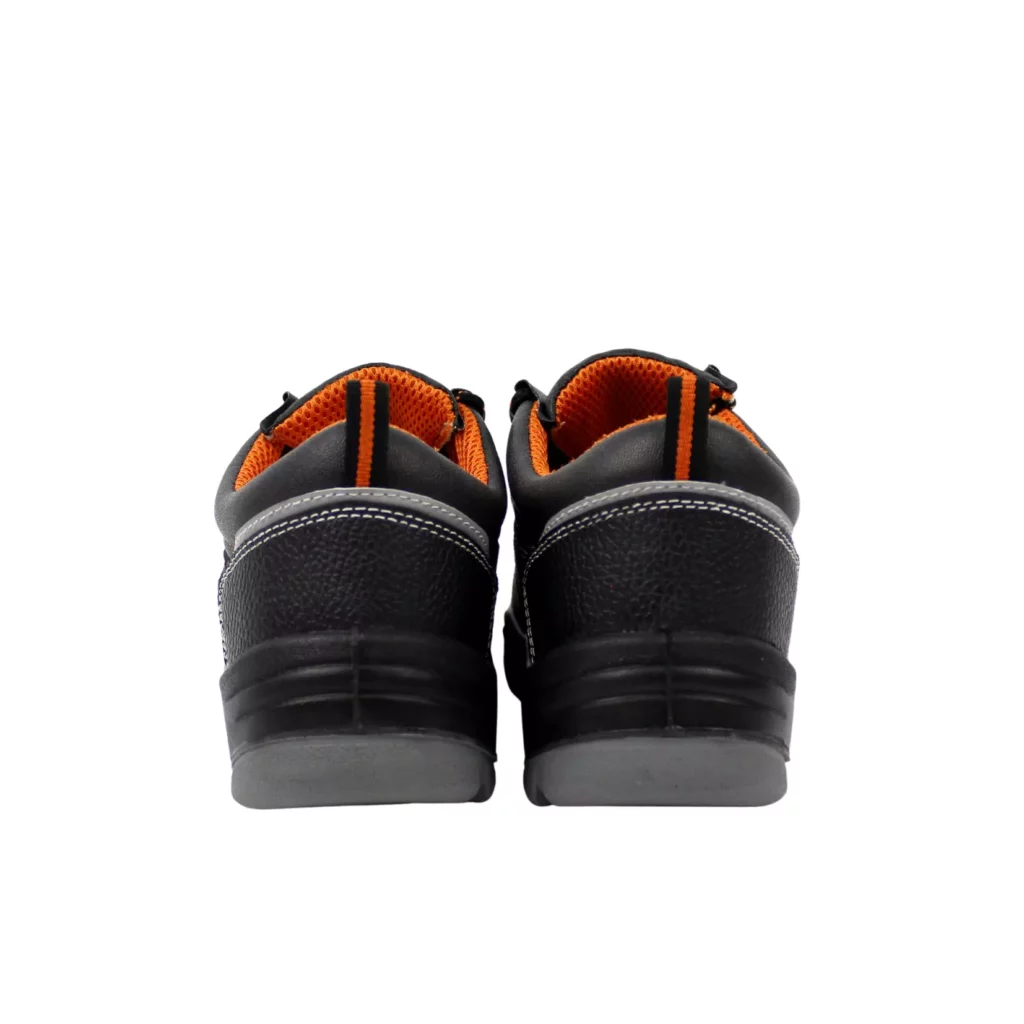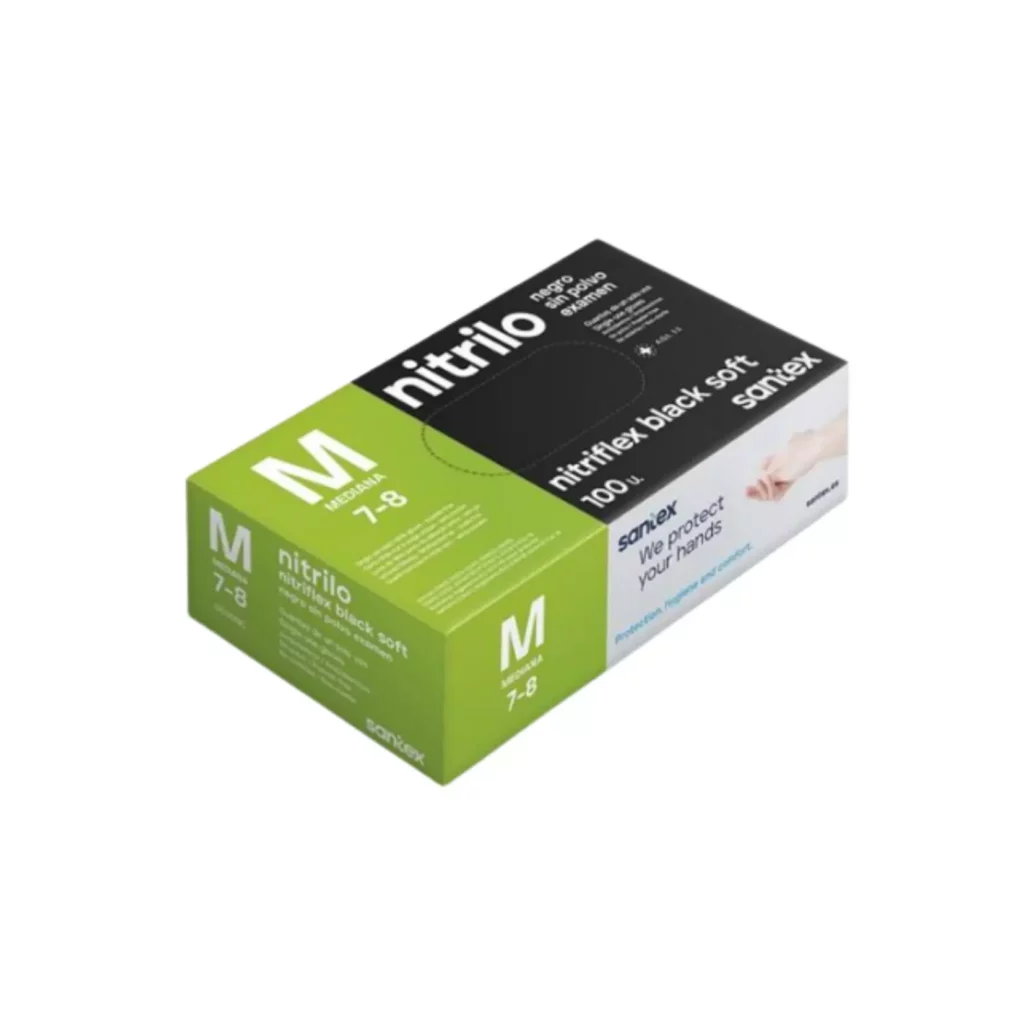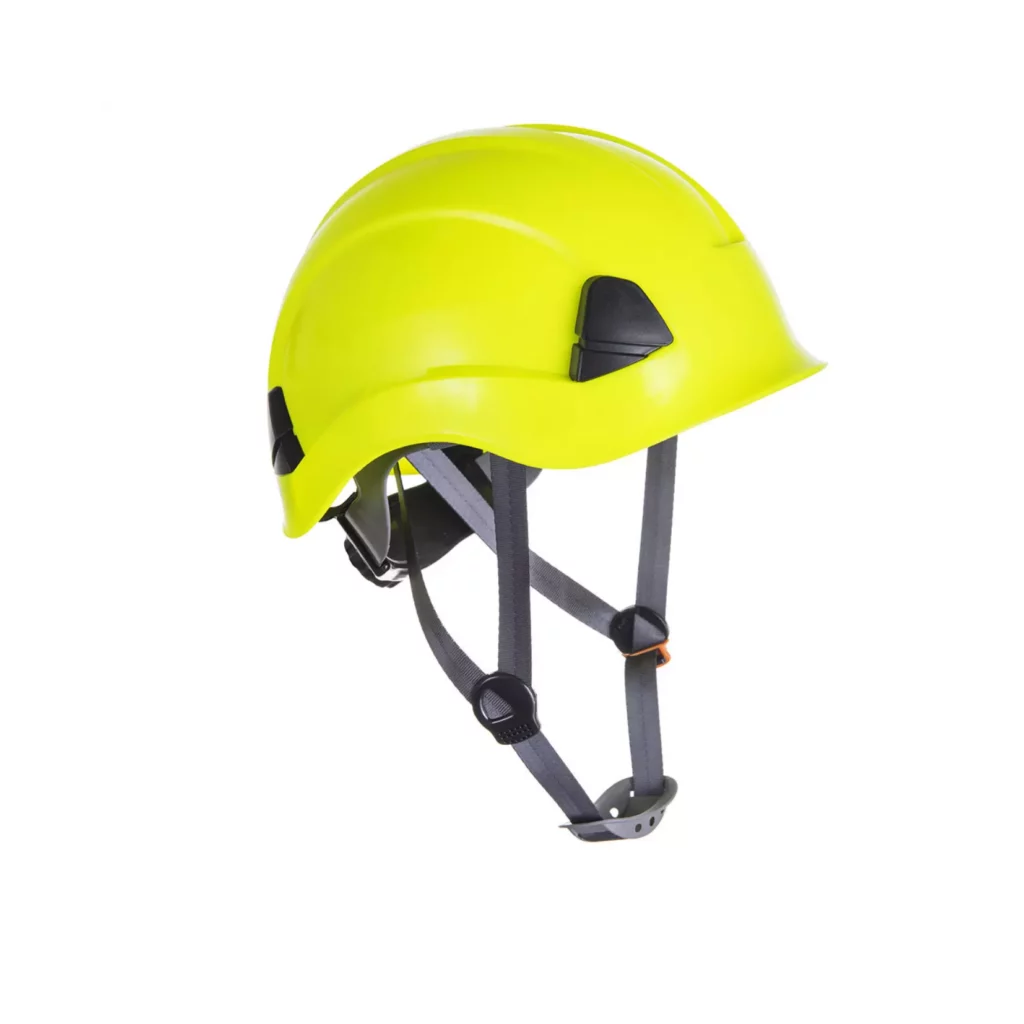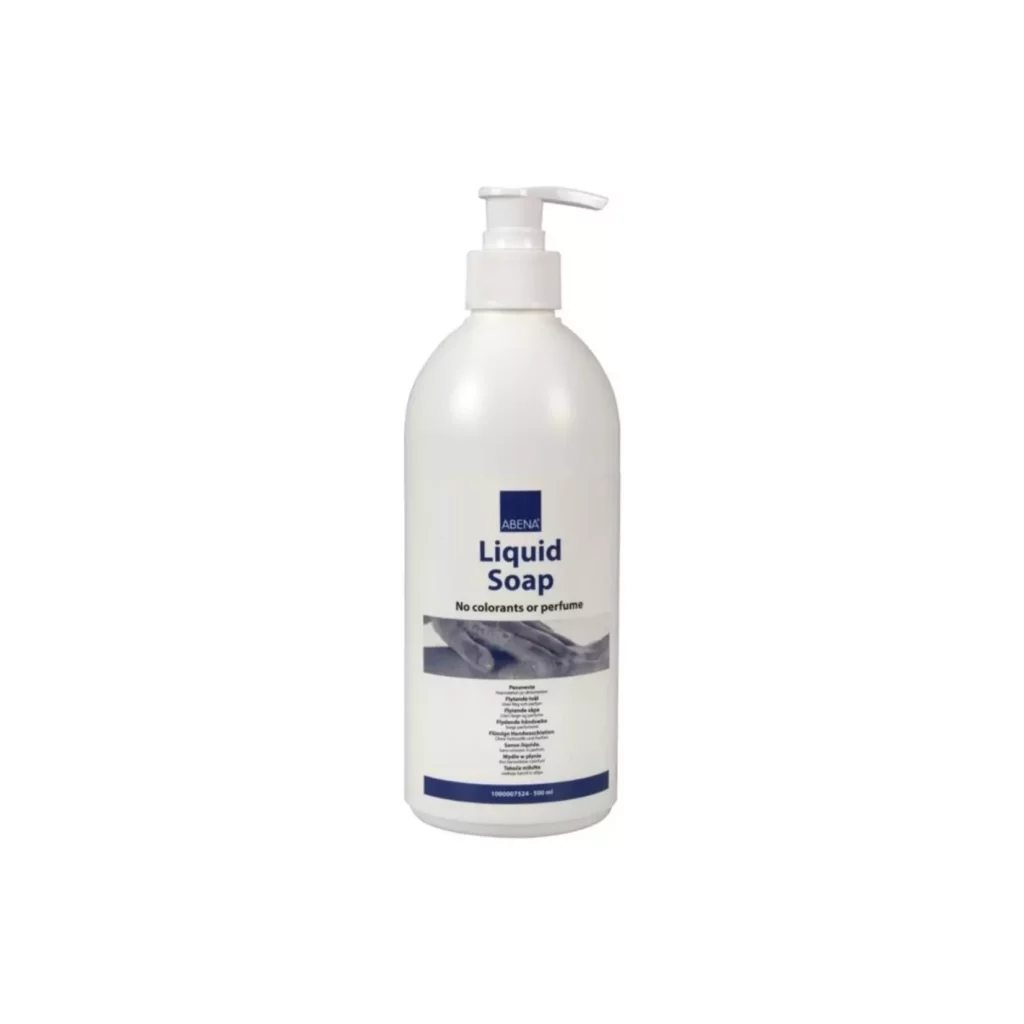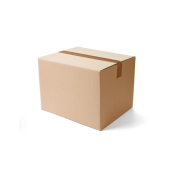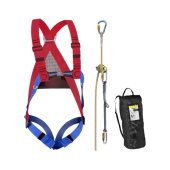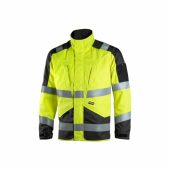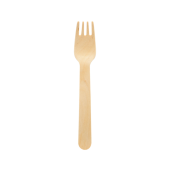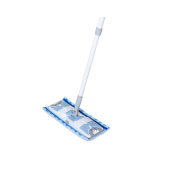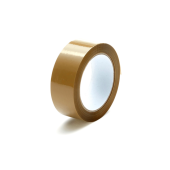Did you know that the National Safety Council reports an annual total of over 53,000 foot injuries followed by a staggering 44.5 million injuries in the workplace caused by slips, trips and falls in the USA alone?
Each one of these statistics stands for a person whose life is affected, and it surely serves as a reminder of the importance of providing workers with the right safety footwear.
That being said, we know how challenging it can be to sift through the multitude of options available, decoding safety standards, and determining which materials are best suited for your unique work environment.
So, if you’re grappling with the challenge of selecting the ideal safety footwear for your workers, this guide will provide you with valuable insights into the factors to consider and the options available, ensuring that you make an informed and confident choice.
Here are the topics we will cover:
- Understanding Safety Shoes Standards In The EU
- What Are Safety Shoes Made Of and Why?
- How to Choose the Right Model
- What Size Safety Shoes Should I Buy?
- Is There A Difference Between Men’s And Women’s Work Shoes?
- Where Do You Need to Wear Protective Footwear?
- Maintenance And Disposal
- Best Safety Shoes Suppliers in Europe
Understanding Safety Shoes Standards In The EU
In Europe, the EN ISO 20345:2011 standard establishes the guidelines for safety shoes based on the required protection levels.
According to this classification, safety shoes are categorized into different classes, each offering distinct safety features:
- SB (Safety Base): These shoes feature a toe guard made of steel, composite, or aluminium. They provide protection against falling objects and have a dent resistance of at least 200 Joules. The heel shock absorption is also at least 200 Joules.
- S1 class: This class of shoes is antistatic and absorbs energy in the heel.
- S2 class: In addition to the features of the S1 class, these shoes offer higher waterproofing.
- S3 class: Incorporating the properties of the S2 class, these shoes have a hardened midsole and an antislip tread.
- S1P class: These shoes, similar to S1 class, feature a steel or steel-free midsole to prevent penetration by nails or other sharp objects.
- S4 class: These shoes have the properties of the S3 class but are entirely made of plastic, making them waterproof.
- S5 class: These shoes, similar to the S4 class, have a hard midsole and an antislip tread.
Apart from these, safety shoe ratings also extend to the following protective attributes:
| Code | Attribute |
| P | Puncture resistance |
| C | Electrical resistance (non-conductive) |
| A | Electrical resistance (anti-static) |
| E | Energy-absorbing heel |
| HI | Heat insulation |
| CI | Cold insulation |
| WRU | Water-repellent uppers |
| HRO | Heat-resistant outsole |
For example, if your workers are operating in an environment where there is a risk of falling objects or foot impacts, then SB class shoes with a steel or composite toe cap would be appropriate. For those working in wet conditions or where there is a risk of electrocution, the waterproof and electrically resistant properties of S4 or S5 class shoes would be more suitable.
You can refer to the following table for more examples of use cases and the level of protection required. Please keep in mind that these are general guidelines. If you have doubts about the best safety class for your use cases, we warmly recommend getting in touch with our experts for a personal consultation.
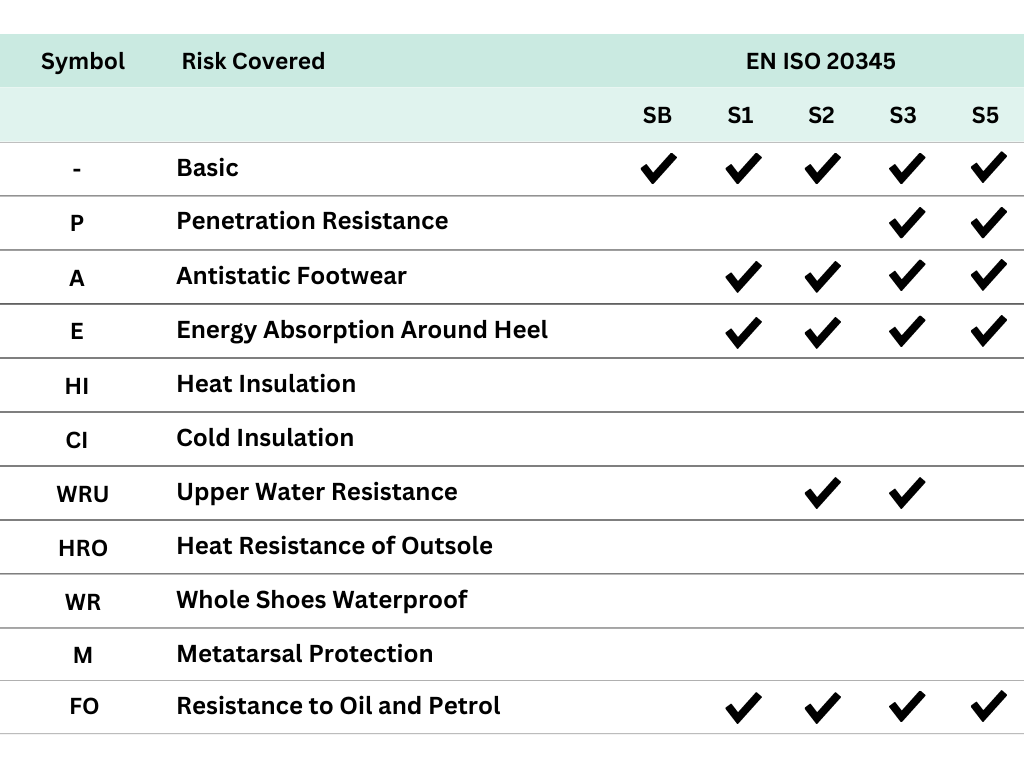
What Are Safety Shoes Made Of And Why?
Safety shoes are crafted from a range of materials, each selected for specific protective properties such as durability, impact resistance, and comfort.
Leather, known for its breathability and adaptability, is a go-to material. For instance, carpenters working in semi-controlled environments might opt for leather boots, benefiting from their form-fitting nature over time. Meanwhile, synthetic materials such as nylon or synthetic leather are lighter and more resistant to water and chemicals. Workers in chemical plants might prefer these, valuing the resistance against potential chemical spills.
Diving into protective elements, steel toe caps remain a top choice in industrial settings like construction sites where the risk of heavy objects falling is frequent. Composite toe caps, utilizing materials like carbon fibre, are preferred in electrical environments because they don’t conduct electricity. Meanwhile, warehouse workers, who need protection but also desire lightweight footwear for easy mobility, might lean towards aluminium toe caps.
When it comes to midsoles, EVA’s cushioning properties make it ideal for healthcare workers who stand for long shifts, offering them comfort throughout. Polyurethane (PU) is durable and absorbs shocks well, making it suitable for dock workers who handle heavy cargo and navigate uneven surfaces.
Concerning outsole materials, rubber‘s excellent grip is invaluable for factory workers, especially if they deal with oil-based machinery, given its resistance to oil. TPU, due to its combined resilience and strength, is especially favoured in rough terrains, such as on mining sites.
Lining materials cater to specific environments. Textile linings, with their breathable nature, are suitable for office settings with air-conditioning, ensuring comfort throughout the day. In contrast, forestry workers might opt for GORE-TEX® boots, appreciating its waterproof properties during rainy conditions.
For insoles, memory foam is a popular choice among retail workers. Spending hours on their feet, they benefit from the foam adapting to their foot shape. On the other hand, factory workers, who tread on hard concrete floors, might find gel insoles more comfortable due to their enhanced shock absorption.
Please notice that these are general recommendations, but we warmly recommend getting in touch with our experts to find the best options for your unique settings.
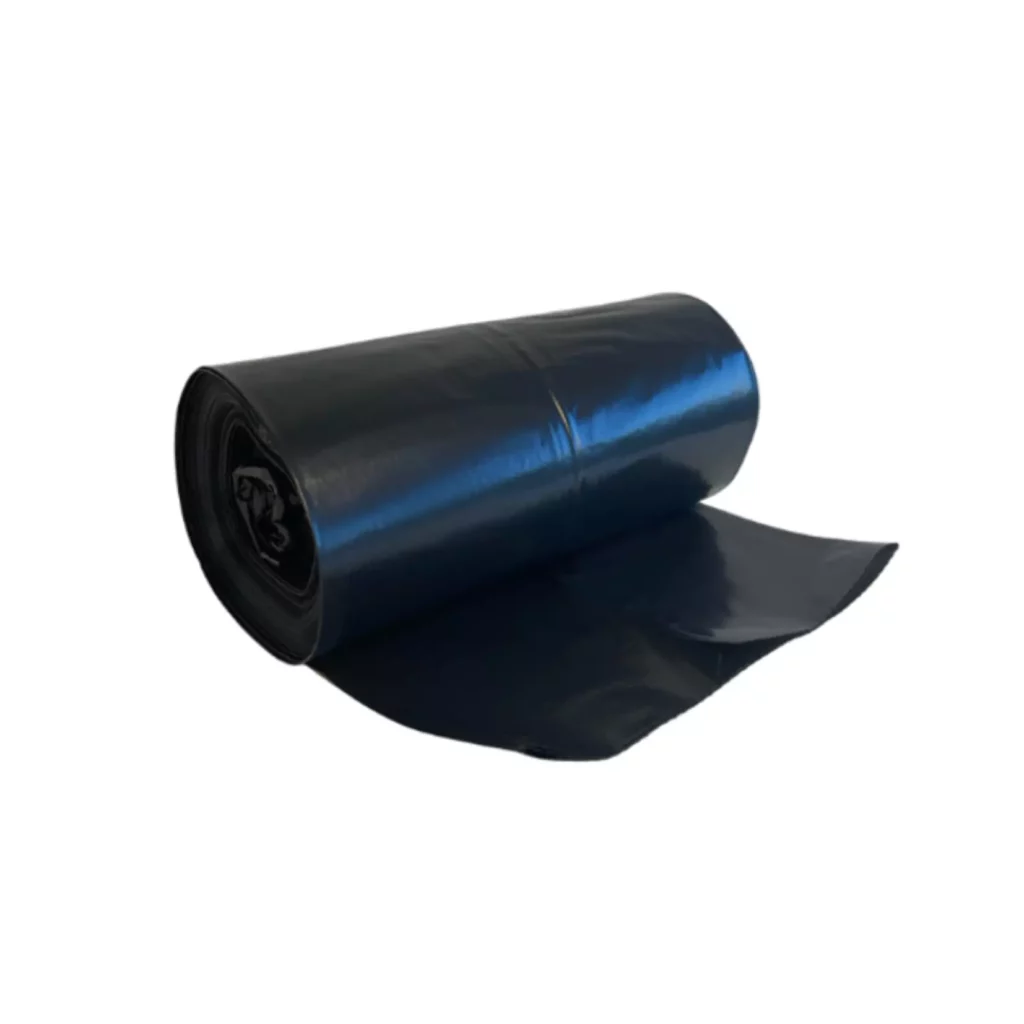

How to Choose the Right Model
The key to selecting the right safety footwear is understanding the specific hazards faced by your workers, and this is done by conducting a thorough risk assessment, especially if your company employs a large number of employees working in diverse settings.
You (or your designated professional) can start with an on-site inspection to identify potential dangers. These can be:
- Falling objects and/or heavy machinery
- Wet and slippery floors
- Build-up of static electricity
- Chemical or metal splashes
- Sharp objects like blades and nails
- Burning objects like molten metal or sparks
After successfully identifying all potential hazards your employees might encounter, you can run an audit of your current safety footwear selection to ensure that it is both appropriate and that it complies with the latest safety standards.
Based on your findings, you might have to source new models that include the needed safety standards, while also taking into account your specific work needs and workers’ preferences.
While you’re gathering your workers’ feedback, also inquire about their preferred shoe cut. High-cut options (like work boots) offer added support around the ankle and Achilles tendon, making them well-suited for roles that require stability. Conversely, low-cut styles afford more ankle flexibility, ideal for jobs requiring frequent kneeling or bending. However, it’s worth mentioning that low-cut shoes offer less Achilles tendon protection.
As a last consideration, make sure you buy the correct size as ill-fitting shoes can cause discomfort and impair work efficiency. Always opt for safety shoes that don’t constrict your workers’ feet or press against their toes, especially around the toe caps. Also, keep in mind that feet can swell over long work hours, so a little extra room is generally a good idea. For this, we recommend initiating shoe fittings for a small group of employees and making the necessary size adjustments if needed.
More of this in the next section.

What Size Safety Shoes Should I Buy?
Selecting the right size is almost as important as selecting the right level of protection. After all, ill-fitting footwear will cause discomfort and in some cases, it can also lead to accidents, reduced productivity, and long-term health issues.
Here are some key points to help you make the right decision:
- Between Sizes: If you can’t decide between two sizes, it’s generally better to go with the larger size. This will give your workers’ feet some room to breathe and accommodate for any swelling that may occur during a long day of work.
- Seasonal Changes: The right size may vary with the seasons. In cold weather, your workers may be wearing thicker socks or even double socks to keep their feet warm. Similarly, some safety shoes come with insulating lining for cold weather. Make sure there is enough room to accommodate these additions without making the shoe too tight. On the other hand, in warm weather, your workers’ feet may tend to swell more, so it’s important to have shoes that won’t become too tight.
- Try-On: If possible, always select a small group of workers for a try-on before purchasing. Ask them to walk around and get a feel for the fit. Uncomfortable shoes can cause distraction and discomfort, and on a job site, that can be dangerous.
- Work Socks: When trying on safety shoes, ask your workers to wear the same type of socks that they would typically wear to work. This will give them a more accurate feel for how the shoes will fit during their workday.
Is There A Difference Between Men’s And Women’s Work Shoes?
Men’s and women’s feet can greatly differ in shape, width, and size. This is why the right choice of safety footwear isn’t just a matter of size but of overall fit.
Generally speaking, women’s shoes are designed with a narrower heel and a wider forefoot compared to men’s shoes. Imagine a woman who typically wears a size 42 in men’s shoes. Even if you provide her with a men’s safety shoe, the fit won’t be ideal if the heel is too wide, causing her foot to slip out, or the forefoot is too narrow, causing discomfort. This woman might actually need a 41 in women’s sizes due to these differences in foot shape.
When it comes to sourcing, you should always make sure that the work shoes are available in sizes and widths suitable for both genders. This might mean sourcing from different suppliers. For example, you might need to order from a supplier that offers a specific line of safety shoes designed for women, in addition to the regular order of men’s safety shoes.
Where Do You Need to Wear Safety Footwear?
Different workplace environments come with specific hazards that require specialized protection.
Here are some examples of distinct workplace situations and the corresponding safety footwear features that you should consider:
- Electric Shock: In industries like electronics manufacturing or electrical repairs, workers handle devices that carry electrical currents. For instance, an electrician working on power lines would require work shoes with anti-static and electrical resistance properties to protect against accidental electrocution.
- Sharp Objects: Construction workers or carpenters often find themselves in environments with nails, shards of glass, and other sharp objects. In these situations, puncture-resistant boots are a must. A construction worker stepping on a nail would benefit from a shoe with a puncture-resistant sole, preventing the nail from penetrating through.
- Falling Objects: In industries like warehousing or factories, heavy objects such as tools or machinery parts can fall from shelves or workbenches. An industrial worker in a factory, for example, would benefit from wearing workshoes with steel or composite toe caps, which provide protection against impacts.
- Explosive or Electrostatic Discharge: In environments like pharmaceutical manufacturing or grain processing, there’s a risk of flammable materials igniting due to static electricity. Workers in these settings should wear footwear with anti-static or electrostatic dissipative properties to mitigate the risk of sparks igniting volatile substances.
- Exposure to Water, Heat, or Cold: Specific industries like fishing or metal smelting expose workers to water, extreme heat, or cold. For instance, a fisherman working on a trawler would need work boots with insulation against cold and water-repellent uppers to keep their feet dry and warm.
- Welding Spray, Molten Metal, or Corrosive Liquids: Workers in metal fabrication or chemical processing are often exposed to welding spray, molten metal, or corrosive liquids. A welder dealing with sparks and molten metal would need footwear with fire-retardant properties and resistance to molten metal.
- Uneven Ground: In outdoor environments like construction sites or hiking trails, the ground is often uneven and poses a risk of sprains or injuries. For example, a surveyor working in rugged terrain would benefit from shoes with ankle support to prevent injuries.
Maintenance And Disposal
Taking care of work shoes is a must to ensure their protective features last. However, no matter how well they’re looked after, even the best safety shoes on the market will reach a point where they need to be replaced.
Here are some indicators that it’s time to get a new pair:
- Visible Protective Components: If you notice a protective element such as a reinforced toe, steel midsole, steel shank, or metatarsal guard starting to show through, replace the boots immediately.
- Dented Toe Caps: Steel toe caps can dent and fail to spring back after a significant impact or puncture. Composite toe caps might not show visible damage as easily, so it’s important to keep track of major incidents that could compromise the integrity of the safety features.
- Separation of Parts or Seams: Safety boots made of rubber or PVC materials may exhibit visible separation of parts or seams as they wear out. If you notice any separation, it’s time to get a new pair.
- Worn Outsoles: Pay attention to the tread of your shoes. When the tread becomes smooth, the shoes will no longer offer adequate slip resistance.
- Leakage: If your job involves working in damp environments or exposure to hazardous chemicals or other corrosive materials, any sign of leakage in your shoes should be a signal to replace them.
In conclusion, routinely checking and caring for your work shoes helps them offer the best protection over their lifespan. If you observe signs of wear and tear, it’s time to get a new pair to stay safe and healthy on the job.
Best Safety Shoes Suppliers in Europe
When looking for reliable industrial safety footwear suppliers in Europe, you should always consider factors such as product specs and fit, compliance with European safety regulations, and pricing. After all, procuring the best safety shoes for your use cases shouldn’t always break the bank.
This is where a wholesale marketplace like Droppe can make a difference.
Droppe’s catalogue includes 150,000 industrial SKUs from 100+ vetted European suppliers and it makes it easier than ever for you to compare their product selection, price, delivery time, and much more.
So, rather than spending countless hours negotiating with different work shoe suppliers, you now have their selections and offers in one single place. Plus, there are no geographical limitations, so your supplier pool will expand throughout Europe.
Additionally, as we know how hard it is to include multiple product specs and safety classes in your search, we’ve created user-friendly search filters to help you quickly locate all the relevant products in a few clicks – so, no time is wasted sourcing through the wrong shoe models.
Try Droppe today to find all the best work shoes from top-rated suppliers in Europe, or get in touch with our product experts for a custom quote tailored to your needs.
Related Articles and Guide
- Choosing The Right Safety Shoes For Construction
- How To Choose Safety Shoes For Electricians
- Steel Toe vs. Composite Toe: Which One Should You Choose?
- How To Choose Safety Shoes For The Kitchen: A Complete Guide
Conclusion
Choosing the best safety shoes for your workers is a decisive factor in safeguarding the well-being, health, and comfort of workers in diverse sectors. Given the myriad options available, it’s important to thoroughly assess your workplace’s unique needs, such as the hazards present and the duties of your staff.
Think about the height of the shoe cut, the sizing, and the protective features needed for your work setting. Verify that the selected safety shoes adhere to applicable safety standards, like the EN ISO 20345 norm in Europe. Regularly check and care for your work shoes to extend their lifespan and maximize their protective capabilities. When wear and tear become evident, replace the shoes.
Next, you can check our complete selection of safety shoes sourced from vetted European suppliers, or get in touch with our experts for a free consultation.

